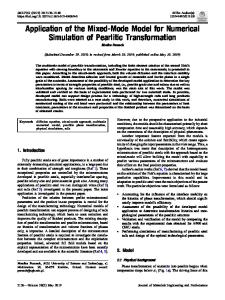Numerical simulation of manufacturing process chain for pearlitic and bainitic steel rails
- PDF / 3,833,261 Bytes
- 18 Pages / 595.276 x 790.866 pts Page_size
- 67 Downloads / 311 Views
(2020) 20:107
REVIEW ARTICLE
Numerical simulation of manufacturing process chain for pearlitic and bainitic steel rails Andrij Milenin1 · Władysław Zalecki2 · Monika Pernach1 · Łukasz Rauch1 · Roman Kuziak2 · Tomasz Zygmunt3 · Maciej Pietrzyk1 Received: 18 January 2020 / Revised: 24 July 2020 / Accepted: 24 August 2020 © The Author(s) 2020
Abstract Computer system for the design of technology of the manufacturing of pearlitic and bainitic rails was presented in this paper. The system consists of the FEM simulation module of thermal–mechanical phenomena and microstructure evolution during hot rolling integrated with the module of phase transformation occurring during cooling. Model parameters were identified based on dilatometric tests. Physical simulations, including Gleeble tests, were used for validation and verification of the models. In the case of pearlitic steels, the process of subsequent immersions of the rail head in the polymer solution was numerically simulated. The objective function in the optimization procedure was composed of minimum interlamellar spacing and maximum hardness. Cooling in the air at a cooling bed was simulated for the bainitic steel rails and mechanical properties were predicted. The obtained results allowed us to formulate technological guidelines for the process of accelerated cooling of rails. Keywords Rails · Controlled cooling · Pearlitic steels · Bainitic steels · Modelling
1 Introduction
* Monika Pernach [email protected] Andrij Milenin [email protected] Władysław Zalecki [email protected] Łukasz Rauch [email protected] Roman Kuziak [email protected] Tomasz Zygmunt [email protected] Maciej Pietrzyk [email protected] 1
AGH University of Science and Technology, al. Mickiewicza 30, 30‑059 Kraków, Poland
2
Institute for Ferrous Metallurgy, ul. K. Miarki 12, 44‑100 Gliwice, Poland
3
ArcelorMittal Poland, al. Józefa Piłsudskiego 92, 41‑308 Dąbrowa Górnicza, Poland
There is a continuous need to improve the mechanical properties of rails used extensively in the railway transportation sector. The extent of improvement in these rails is known to be governed by factors like wear resistance, fatigue strength, etc. These properties are in turn dependent on microstructuraol constituents and their morphology. Properties of pearlitic rails are strongly dependent on the interlamellar spacing and the fraction of cementite within the pearlite. Experimental tests [1] have shown that the structure of fine pearlite, obtained by lowering the transformation temperature, increases significantly the hardness of the pearlitic steels. The even greater degree of microstructure refinement can be achieved by transforming steels having complex chemical composition to bainite [2, 3]. The final microstructure of rails is obtained by precise control of parameters of the whole manufacturing chain including multi-pass hot rolling and heat treatment. These parameters can be determined by numerical models. The development of the finite element (FE) thermal–mechanical-metallurgical
Data Loading...











